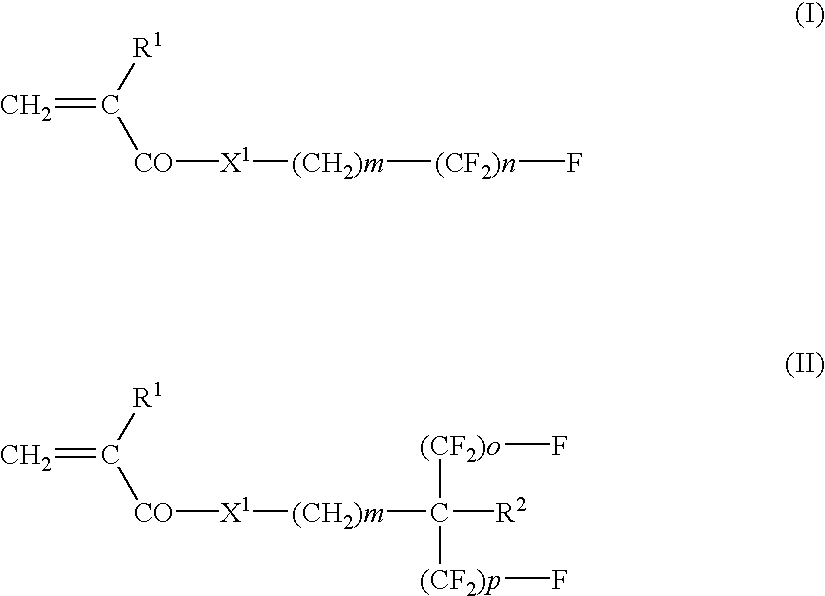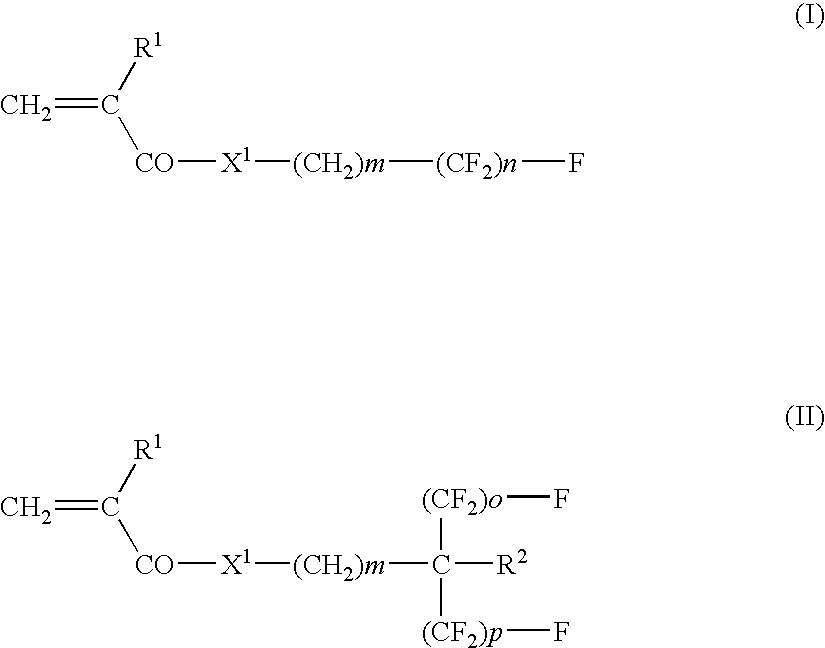Fluoroaliphatic group-containing copolymer
a fluoroaliphatic group and copolymer technology, applied in the field of high molecular weight compounds, can solve the problems of uneven distribution of applied film on the air boundary side, low surface energy, and reduced surface energy, and achieve excellent solubility and/or dispersibility, reduce sensitivity, and improve the effect of foregoing surface quality and solubility
- Summary
- Abstract
- Description
- Claims
- Application Information
AI Technical Summary
Benefits of technology
Problems solved by technology
Method used
Image
Examples
synthetic example 1
[0240]To a glass flask equipped with a stirring device, a condenser and a thermometer, there was added 100 parts by weight of methyl ethyl ketone (hereunder referred to as “MEK”) and it was heated to 75° C. in a hot water bath, followed by dropwise addition of a mixture containing 50 parts by weight of 2,2,3,3,4,4,4-heptafluorobutyl acrylate (I-1), 45 parts by weight of Blemmer AP-400 (available from Nippon Oil and Fats Co., Ltd.) or a monoacrylate compound having propylene oxide on the side chains, 5 parts by weight of Blemmer AE-400 (available from Nippon Oil and Fats Co., Ltd.) or a monoacrylate compound having ethylene oxide on the side chains, 100 parts by weight of methyl ethyl ketone and 1 part by weight of V-601 (available from WACO Pure Chemical Co., Ltd.) as a polymerization initiator using a dropping funnel in a nitrogen gas stream over 2 hours. After the completion of the dropwise addition, the content of the flask was stirred at 75° C. for 2 hours and further at 90° C. ...
synthetic example 2
[0241]To a glass flask equipped with a stirring device, a condenser and a thermometer, there were added 60 parts by weight of fluorinated alkyl group-containing acrylate monomer (II-6), 40 parts by weight of a monoacrylate compound carrying copolymers of ethylene oxide and propylene oxide on the side chains and 200 parts by weight of MEK, the mixture was heated to 75° C. in a nitrogen gas stream, followed by addition of one part by weight of V-601 as an initiator and 10 parts by weight of lauryl mercaptan as a chain transfer agent, stirring the mixture for 5 hours and further stirring the same at 90° C. for additional 2 hours. The weight average molecular weight (polystyrene standard) of the resulting polymeric compound (fluorine atom-containing polymer (b)) was determined by gel permeation chromatography technique and it was found to be 8,300.
synthetic examples 3 to 6
[0242]The same procedures used in Synthetic Example 2 were repeated to thus synthesize fluorine atom-containing polymers (c) to (f) listed in the following Table 1.
[0243]
TABLE 1F atom-weightcontain-ratio ofingeachpolymersconstitution unitsunitMw(a)50:45:558000(b)60:408300(c)55:4512800(d)40:50:1048000(e)40:20:4026000(f)70:3067000(g)*40:50:1034000(h)*40:6043000*Comparative compounds
PUM
| Property | Measurement | Unit |
|---|---|---|
| thickness | aaaaa | aaaaa |
| diameter | aaaaa | aaaaa |
| solubility | aaaaa | aaaaa |
Abstract
Description
Claims
Application Information
 Login to View More
Login to View More - R&D
- Intellectual Property
- Life Sciences
- Materials
- Tech Scout
- Unparalleled Data Quality
- Higher Quality Content
- 60% Fewer Hallucinations
Browse by: Latest US Patents, China's latest patents, Technical Efficacy Thesaurus, Application Domain, Technology Topic, Popular Technical Reports.
© 2025 PatSnap. All rights reserved.Legal|Privacy policy|Modern Slavery Act Transparency Statement|Sitemap|About US| Contact US: help@patsnap.com



